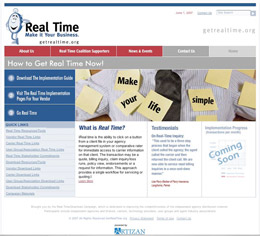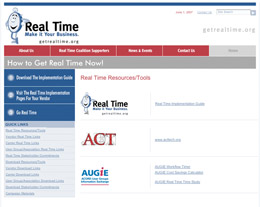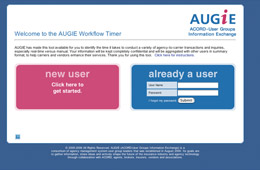The industry's B.H.A.G.
Insurance industry sets an audacious goal for real time adoption
By Nancy Doucette
The acronym BHAG (big hairy audacious goal) was coined by James Collins and Jerry Porras in their best-seller Built to Last: Successful Habits of Visionary Companies. A BHAG (pronounced: Bee-HAG) is a form of vision statement. According to Collins and Porras, “A true BHAG is clear and compelling, serves as a unifying focal point of effort, and acts as a clear catalyst for team spirit. It has a clear finish line, so the organisation can know when it has achieved the goal; people like to shoot for finish lines.”
The Real Time/Download Campaign is a BHAG in the truest sense. Launched in late April 2007, the campaign is backed by agents and brokers, carriers, technology providers, user groups, and agency and industry associations. The purpose of the initiative is to increase awareness of real time and download technology and to increase implementation of these interface capabilities by agencies and their carriers. In fact, the campaign goal is to double the use of real time in the industry by May 2008.
Audacious.
But even prior to the launch of the campaign, grassroots efforts were underway to spread the word that real time transactions can boost an agency’s bottom line immediately by streamlining workflows and freeing agency staff to round existing accounts and generate new business.
In November and December 2006, the Independent Insurance Agents & Brokers of New York (IIABNY) held a series of road shows around the state. Three sessions were held upstate, and three were held downstate. Cyndy Smith, vice president of technology for Syracuse-based Haylor, Freyer & Coon, Inc., and chair of the technology advocacy committee for the IIABNY, coordinated the effort. Each road show brought together three carriers and four comparative rating vendors for a half-day program.
One portion of the program included demonstrations of real time inquiry transactions initiated in the agency management system using either TransactNOW or Transformation Station. “That’s key,” Smith says, “that transactions are initiated in the agency management system. Real time communication provides a consistent workflow for agencies to use with their carriers. Additionally, it automates logons to carrier Web sites, which is a big time saver.” The comparative rating vendors demonstrated their real time capabilities during their portion of the program.
Smith says the carriers that participated—New York Central Mutual (a large regional in New York state), The Hartford and Progressive were selected because of their “footprint” in the state and their involvement in the whole real time initiative—participating in ACT, AUGIE and the various comparative rating programs. The comparative rating vendors that participated—AMS SETWrite, Applied Systems through Transformation Station, EZLynx, and FSC—were selected based on the number of users they have in the state.
“We had about 100 participants at each location,” Smith reports. “The IIABNY has approximately 1,300 members, so for us to share this information with about 600 of those members with these road shows was great.” However, she acknowledges, the management side of real time implementation may require some energy and creativity. “You may find some CSRs who think real time is fabulous and others who won’t use it because it’s new. Management needs to work with the folks who are uncomfortable to get them to the point where they realize the value.
“Some CSRs may have heard from early adopters of real time that there were problems,” she continues, “so they will resist it without even trying it. The products have matured and are more reliable. There are significantly more carriers involved. It’s the right time to get real time.”
Free lunch
Keith Savino, CPIA, executive vice president and COO of Warwick Resource Group, headquartered in Warwick, New York, sits on the board of directors of ACORD; but he confides that early on, he was disappointed at the real time implementation in his own agency. His management system has a report capability that provides him with a summary of real time activities for staff members. At the outset of his implementation efforts, he discovered that he had people who “dabbled” in real time. And surprisingly, the staffers who were less enthusiastic about technology in general were the ones who embraced real time more quickly.
The reports also show the carriers with which the agency does the most real time activities. “If I see that transactions with one carrier are well below the others, I can find out why. Maybe we have fewer policies with that company. Or, maybe their real time implementation isn’t as easy to use,” he explains.
Bottom line, though, Savino wanted to increase real time usage in the agency so he ran a 12-week contest. The person with the greatest number of real time inquiries during a one-week period won a free lunch. “We set the dollar amount and all the winner had to do was present us with the receipt,” he recalls. To encourage greater participation, the agency also had prizes for those with the highest three-week aggregate. “People realized that their performance had a cumulative effect.
“The ‘seat of the pants experience’ of clicking a button while you’re talking to your client and then realizing that the transaction is complete as soon as the phone call is complete—that’s huge,” he adds. To make the most of these customer interactions, he recommends asking some open-ended questions before responding to the client’s inquiry. “Before your CSR answers the billing question, for instance, he or she should take a quick look at the policies in force. They can press the real time inquiry button to continue that transaction in the background, but in the few moments it takes for that to be processed, they can chat with the customer about coverage that the agency doesn’t currently write for that customer and offer to quote it for them.”
Savino observes that the way agents are doing personal auto business in New Jersey has been evolving at a quick pace. Changes in the New Jersey auto market had sparked competition, making real time transactions a business necessity. “It was like somebody flipped on the light switch,” he says. “Not only are we writing the business like we haven’t been able to do in the past, but we need all our technology underpinnings in place.” The PIANJ business issues committee, of which Savino is a member, wanted to address what he describes as “the pain of trying to write business.”
Predictably the discussion moved in the direction of technology and from that discussion, the “Get Real Time” program was spawned. Held in Edison, New Jersey, in mid-April 2007, the program drew some 150 attendees. Presenters demonstrated real time transactions involving accounts with the carriers that sponsored the event—The Hartford, New Jersey Skylands, Ohio Casualty and Progressive Drive Insurance.
Real time comparative rating demonstrations were also part of the program, with AMS SETWrite, EZLynx, IVANS Transformation Station and SeaPass participating. The program also included a presentation by Cal Durland, CPCU, a Real Time/Download Campaign leader and facilitator of the ACORD-User Group Information Exchange (AUGIE). She showed participants the all-industry getrealtime.org Web site, sponsored by a coalition that includes PIANJ. Durland told participants at the “Get Real Time” program that they were the first large group to see the new site which had just gone live the day before. They were also the first large group to see “Eddie” the Real Time/Download Campaign logo which includes the tag line “Make it Your Business.”
“Eddie (a semi-acronym for ‘ease of doing business’) is designed to appeal to the people who will be clicking the button,” Savino explains. “And the phrase ‘Make it Your Business’ underscores the business aspect of real time. Implementing real time is not an IT project. In fact, it’s not a project at all. It’s a process. The decision to move toward real time is a decision to improve efficiency.”
Strategic value
Jeff Yates, executive director of the Agents Council for Technology and a leader of the Real Time/Download Campaign, elaborates. “One purpose of the campaign is to help more agency principals see the strategic value of technology. An agent recently told me he is ‘saving’ more than five hours per month per CSR, just by doing real-time inquiry.” As a result, that agency has been able to implement a proactive contact program. “That’s a key point,” Yates emphasizes. “Once you gain the efficiencies, you need to use the efficiency to move your agency to the next level in terms of proactive customer service or a more disciplined sales process.”
Another important aspect of real time activity is download, Yates continues. “We call this the ‘Real Time/Download Campaign’ because download becomes more important in a real time environment,” he explains. “Download enables the round trip of data back into the agency management system following a real time transaction. Having this downloaded information in the agency management system also is essential to performing many real time transactions most effectively.”
Real time resolves some of the industry’s major hot-button issues, Yates says. He recalls that the AUGIE survey released in 2006 (www.augiesurvey.org) revealed widespread agent frustration due to having to use carrier proprietary Web sites, having to manage multiple passwords, training on disparate systems, and duplicate entry. “As real time continues to mature,” he says, “we can realize the agents’ vision of working in a consistent manner with multiple carriers.”
As with any new initiative, though, management’s involvement is essential to its success. “Implementing real time needs to be viewed as a corporate goal,” Yates suggests. “Agency principals have to drive this and monitor employees to make sure they are using the real time tools.”
Show me the money
Lately, when Jim Rogers, director of agency interface and technology strategy for The Hartford, visits an agency and meets with the agency principal, he brings along that agency’s monthly Real-Time Agency Usage Report. “It’s an ‘at-a-glance’ view of real time utilization within the agency,” Rogers explains. “It’s broken down by user and by transaction type—commercial lines, personal lines, billing, claims, and policy view—the standard real time transactions.”
The report also presents what the cost savings would be if all transactions done by the agency through The Hartford were handled via real time rather than via The Hartford’s proprietary Electronic Business Center (EBC). Rogers says that the costs are based on an average cost per CSR. “It gives principals a good ballpark figure,” he says. “There’s frequently a look of surprise on the principal’s face the first time I bring the report to the agency and the principal sees how much not using real time is costing the agency,” he continues. “For some, they’re surprised to learn that no one on staff is using the real time tools. For others, they discover that it is being underutilized.”
Rather than using the “ballpark” figures that come with the report, Rogers says that some principals prefer to take the transaction numbers from the report, plug in the actual salary numbers for each staff person and then use the calculator available at the getrealtime.org Web site. “We’re giving agencies more choice,” he adds. “They can use the EBC for an inquiry or they can leverage Transformation Station or TransactNOW—right from their management system.” As a supporter of the Real Time/Download Campaign, The Hartford donated a prototype of this report to the campaign.
Jeff Yates points out that there’s also a link to AUGIE’s Real Time Study at the getrealtime.org Web site. “To sum up the study,” he says, “real time transactions can generally be done in about half the time that transactions via a carrier Web site can be done.” There are a variety of tools at the Web site—an implementation guide, links to resources and information about real time and download, and a trouble-shooting guide. Yates explains that the Independent Agent’s Real Time Implementation Guide discusses the benefits, functionality and workflows for real time. “Principals can get a quick introduction to real time so they understand it from a management perspective,” he adds. Going forward, the user groups will add to the Implementation Guide, customizing it for their specific systems.
The Implementation Guide points out that real time isn’t just in personal lines. Commercial lines inquiry capabilities and some real time commercial ratings are currently available. For example, The Hartford ExpressWay® for Small Business is a newly launched tool which resolves some of the duplicate entry frustrations that occur when quoting small business risks—BOPs, workers comp and commercial auto. New client information is entered into the agency management system, or an existing client’s information is updated, Rogers explains, and then the agent answers a few additional questions from The Hartford. “The agent pushes a button and moments later, they receive back a quote and the option for a proposal that can be printed out or forwarded to the client for a decision,” he says.
Haylor, Freyer & Coon tested the product prior to its release, according to Cyndy Smith. She reports that the keystroke savings and rapid response time enable the agency to turn around quotes more quickly. “Our CSRs have embraced the technology because it fits so well into our workflow,” she adds.
A distinct advantage
“If an agency is standing still, then it is falling behind competitors,” declares Cal Durland. She notes that agencies that implement the real time capabilities that are available in the current version of most agency management systems “gain a distinct business processing advantage.” To help agencies overcome some of the anxiety that frequently accompanies the introduction of new technology-based workflows—such as real time transactions—the “Power of Change®: Performance-Oriented Workflows Ensure Results” program is being re-introduced to the industry in conjunction with the Real Time/Download Campaign. This seminar, originally unveiled by ACORD in the mid-1990s, is now being managed by AUGIE, with support from the industry. Like the Real Time/Download Campaign, Power of Change is another industry initiative, she says.
Durland explains that during the five-step Power of Change process, principals and staffers agree to adopt real time and download capabilities. Having made that agreement, they then need to identify problem workflows, prioritize them, and then brainstorm to find solutions. “We don’t provide set workflows,” she says. “We talk about how each individual agency does its work, what can be done to improve its workflows and in the process cut out some of the cost to become more efficient. People get used to a certain way of doing things and they think it’s easier than adopting a new workflow. We’re demonstrating that it’s not. Once people work in a new way, they discover they can become more efficient.”
Case in point: After the “Get Real Time” program in Edison, New Jersey, Durland heard back from one of the attendees, an agency principal. He’d gone back to his agency and asked his staff if they were using any real time capabilities. No one was. So he chose one of the CSRs to do a transaction by logging into the carrier Web site and going through the usual steps. The agency principal performed the same transaction on one of the agency’s slower computers using the real time capability available through the agency management system. They started at the same time and almost immediately, Durland recalls, the principal announced his transaction was complete. “The CSR accused him of cheating,” she says with a laugh.
“The Power of Change helps create the right environment in the agency to move toward a real time workflow,” notes Yates. Its five steps include: focusing on the customer, finding the costs, getting the costs out, streamlining the workflow, and ensuring results. Abbreviated versions of the process will be presented at user group meetings and association meetings.
“There are a lot of good things happening that will help the Real Time/Download Campaign reach its goal of doubling the number of real time transactions by May 2008,” Durland concludes. “We can reach the goal in a year, just by increased awareness.” *
For more information:
Real Time/Download Campaign
Web site: www.getrealtime.org
Power of Change
Web site: www.acordadvantage.org |
|
Click on image for enlargement |
 |
| |
The goal of the Real Time/Download Campaign is to double the use of real time in the industry by May 2008.
|
| |
 |
| |
 |
|
Real Time/Download Lexicon
At the getrealtime.org Web site, visitors will find real time tools and resources, as well as links to participating organizations. It also provides definitions for some of the terms the industry is going to be hearing a lot about in the coming months.
Real time. Real time is the ability to click on a button from a client file in your agency management system or comparative rater and gain immediate access to carrier information on that client. The transaction may be a quote, billing inquiry, claim inquiry/loss runs, policy view, endorsement or a request for information. This approach provides a single workflow for servicing or quoting.
Download. Download is the movement of customer policy data from an insurer to its partnering agency or brokerage’s agency management system. This download directly to the agency management system normally occurs after a transaction is performed by an agent, such as adding a vehicle or changing a deductible; or by the insurer, such as the creation of an automatic renewal notice. |
|


